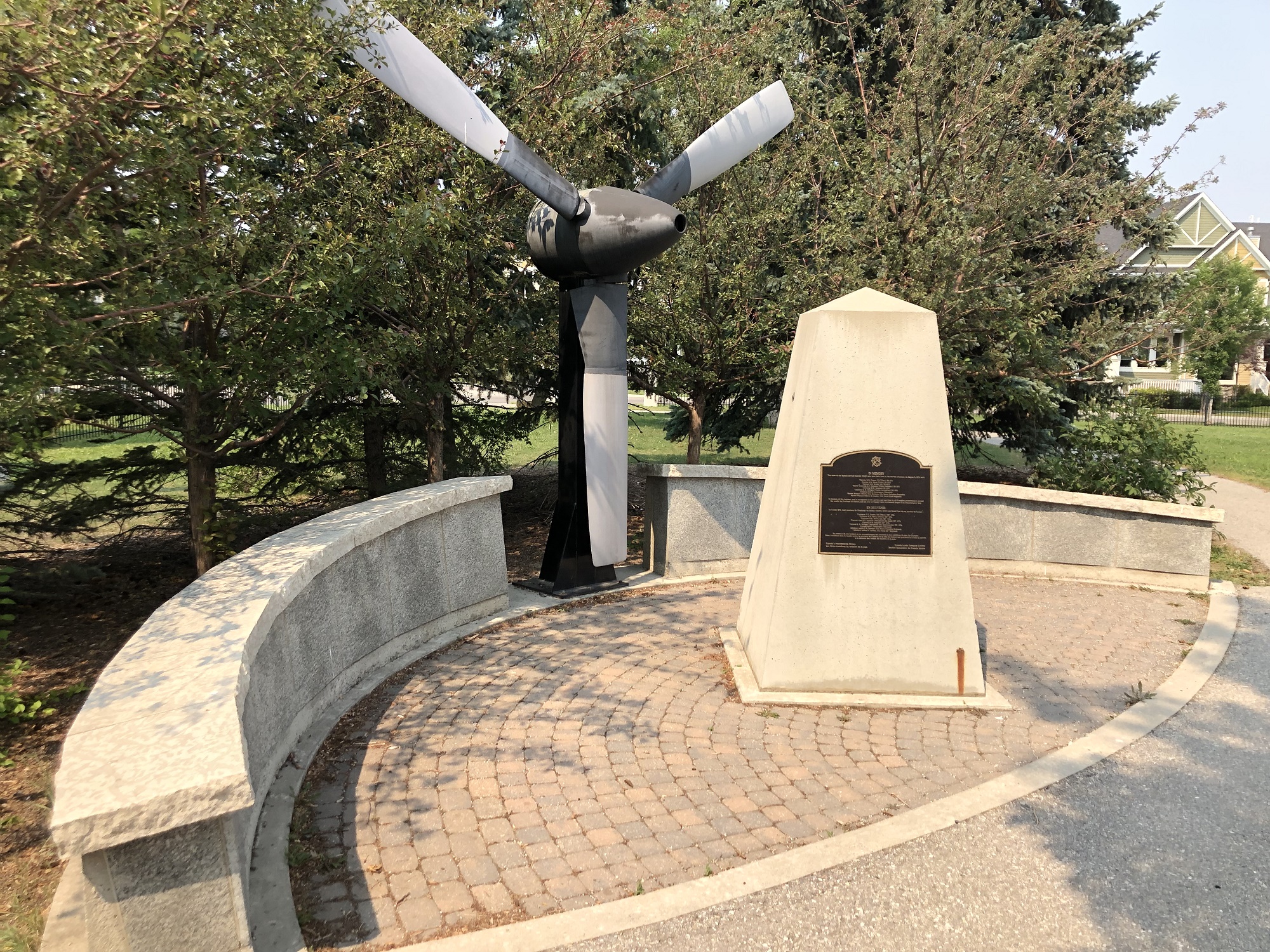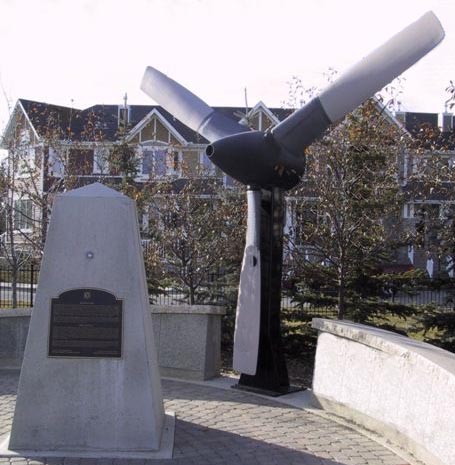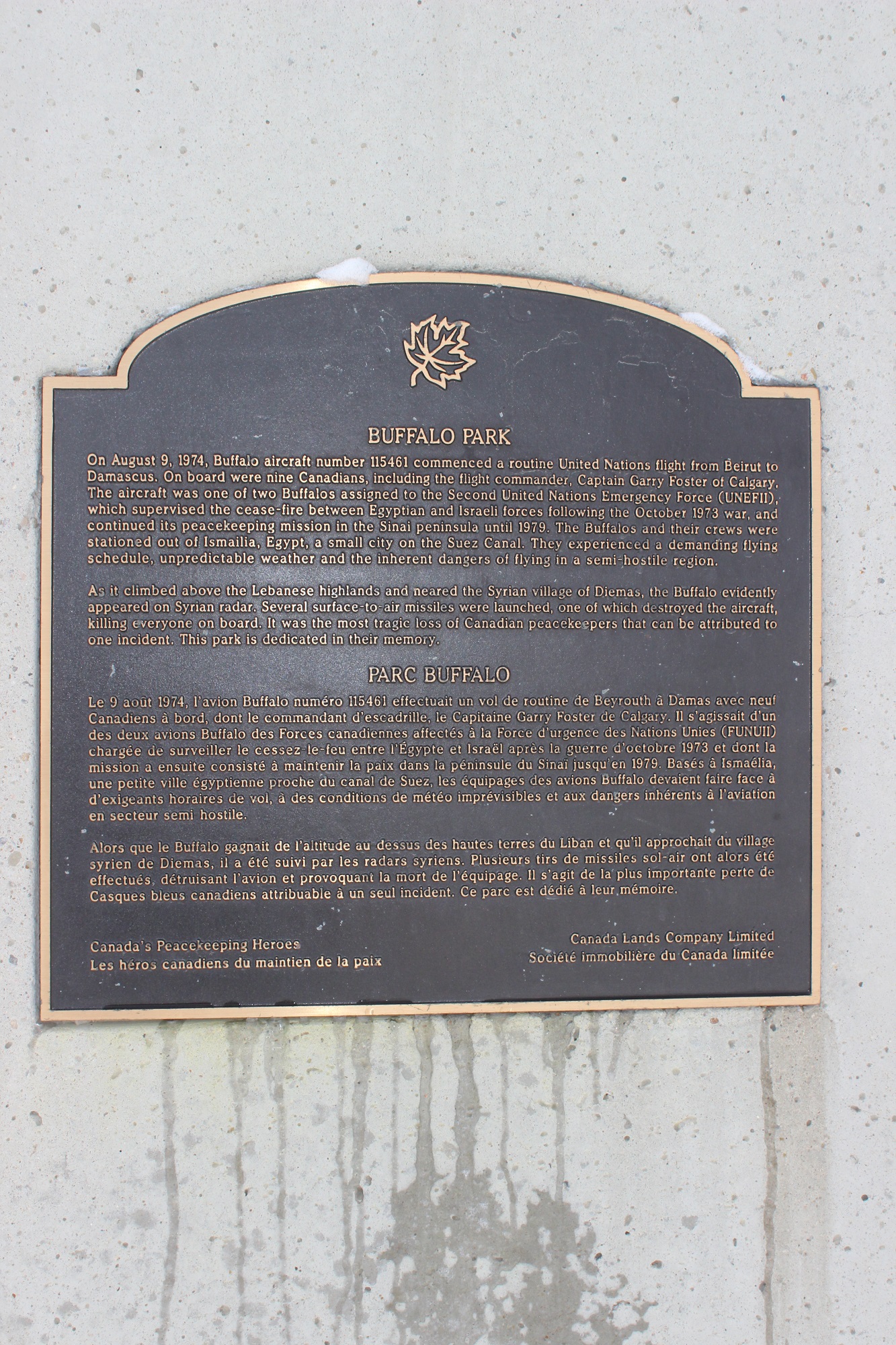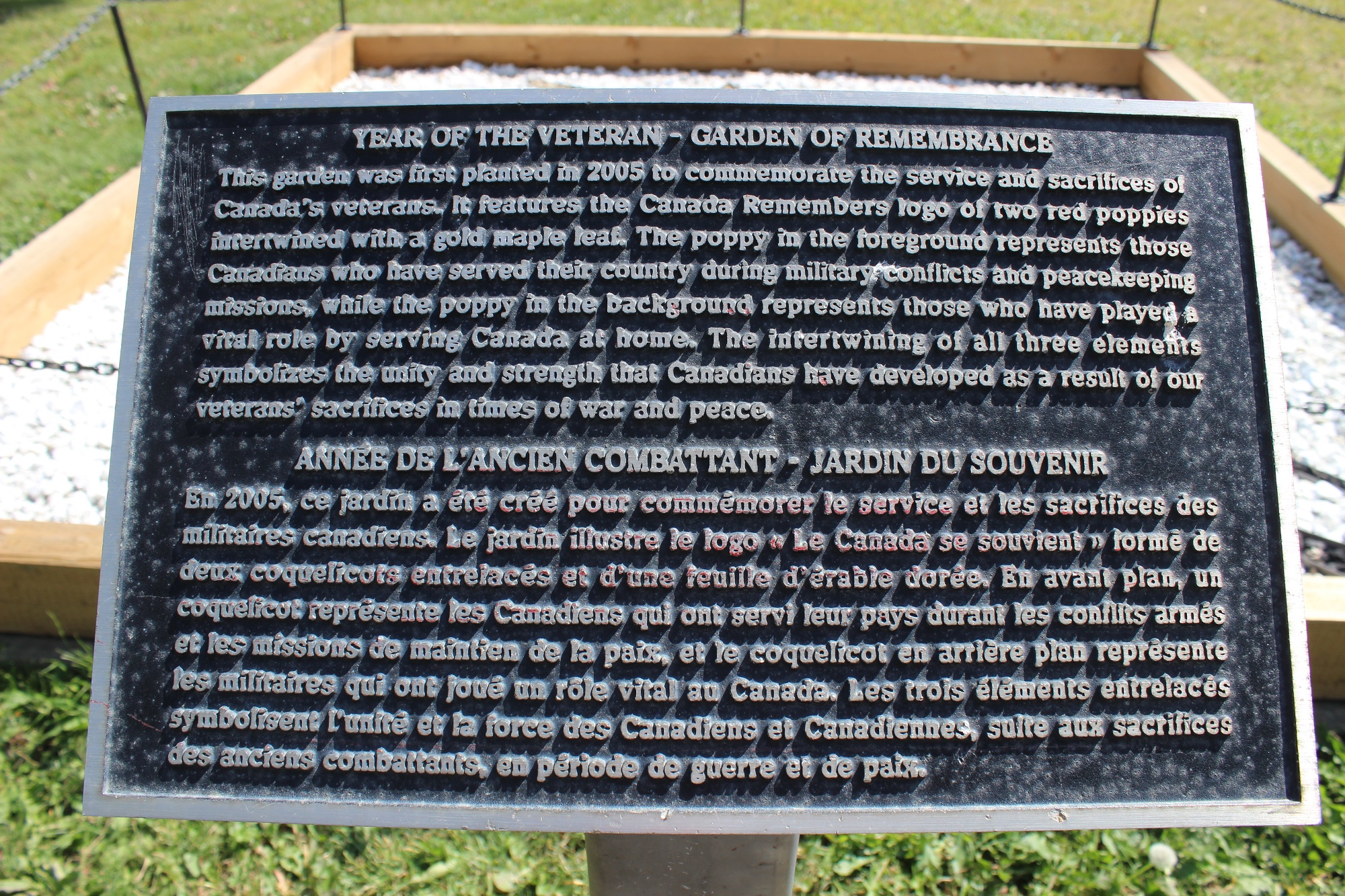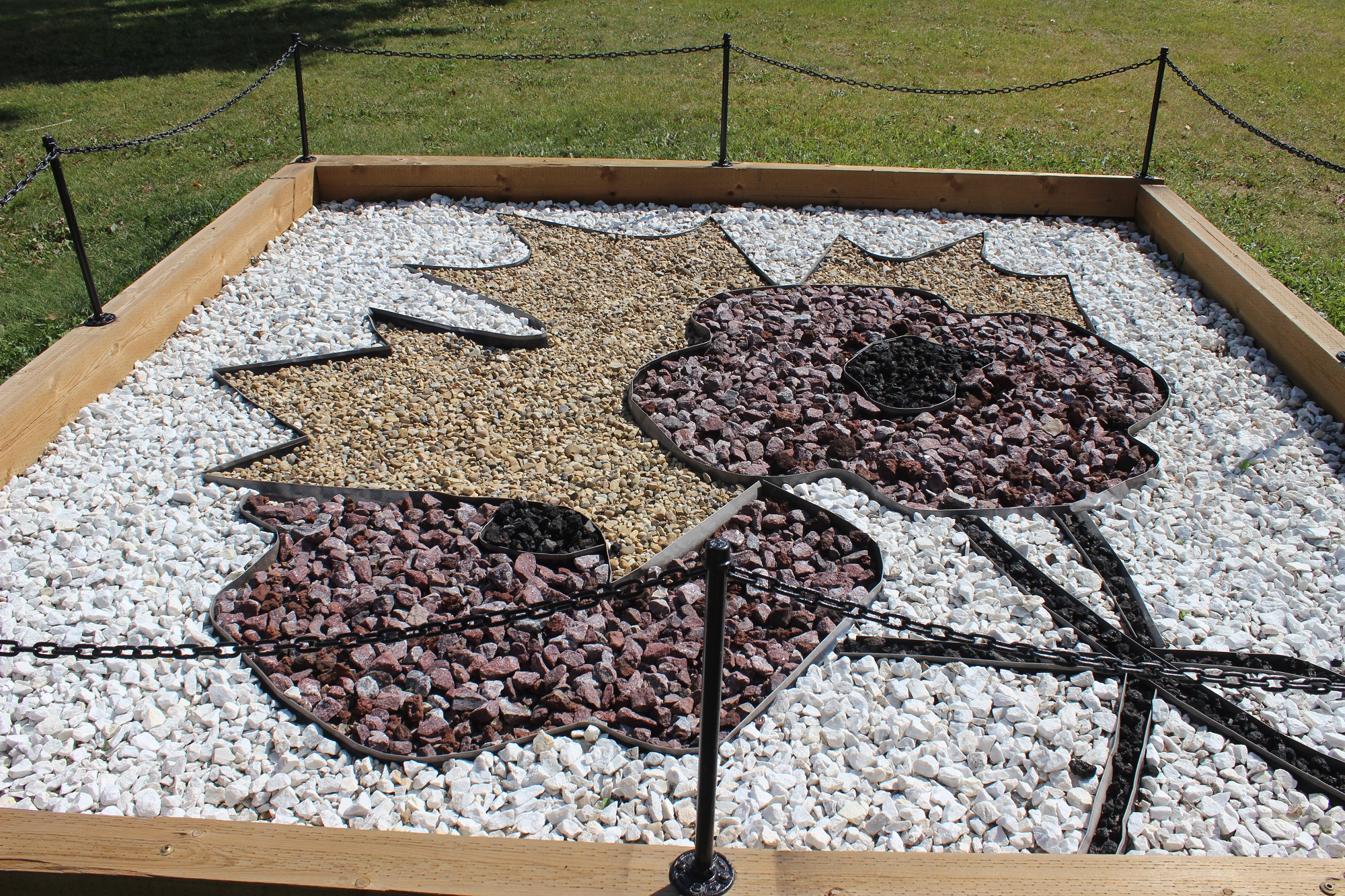[obelisk at entrance/obélisque à l`entrée ]
BUFFALO PARK
[plaque]
IN MEMORY
The crew of the Buffalo aircraft number 115461 who gave their lives in the service of peace on August 9, 1974 were:
Captain G.G. Foster, CD (Pilot) 116 ATU
Captain K.B. Mirau (Pilot) 116 ATU
Captain R.B. Wicks, CD, 116 ATU
Master Coporal R.C. Spencer (Flight Engineer) 116 ATU
Corporal M.W. Simpson 116 ATU
Corporal B.K. Stringer (Traffice technician) 116 ATU
Corporal M.H.T. Kennington (Steward)
Master Warrant Officer, C.B. Korejwo, CD, Royal Canadian Regiment
Master Warrant Officer G.Landry, CD, Royal 22nd Regiment
In memory of this incident, and in recognition of the service and sacrifice by all Canadian peacekeepers around
the world, the Province of Alberta and the City of Calgary have proclaimed August 9 as Peacekeepers' Day.
EN SOUVENIR
le 9 août 1974, neuf membres de l'équipage du Buffalo numéro 115461 ont donné leur vie au service de la paix :
Capitaine G.G. Foster, CD (Pilote) 116e UTA
Capitaine K.B. Mirau (Pilote) 116e UTA
Capitaine R.B. Wicks, CD, 116e UTA
Caporal chef R.C. Spencer (Mécanicien de bord) 116e UTA
Caporal M.W. Simpson 116e UTA
Caporal B.K. Stringer (Technicien des mouvements) 116e UTA
Caporal M.H.T. Kennington (Steward)
Adjudant maître, C.B. Korejwo, CD, Royal Canadian Regiment
Adjudant maître G.Landry, CD, Royal 22e Régiment
En souvenir de cet incident et en reconnaissance des services et des sacrifice de tous les Casques
bleus canadiens dans le monde entier, la province de l'Alberta et la Ville de Calgary ont proclamé le 9 août la journée
à la mémoire des soldats du maintien de la paix.
Canada's Peacekeeping Heroes
Les héros canadiens du maintien de la paix
Canada Lands Company Limited
Société immobilière du Canada limitée
[plaque]
BUFFALO PARK
On August 9, 1974, Buffalo aircraft number 115461 commenced a routine United Nations flight from Beirut to
Damascus. On board were nine Canadians, including the flight commander, Captain Garry Foster of Calgary.
The aircraft was one of two Buffalos assigned to the Second United Nations Emergency Force (UNEFII),
which supervised the cease-fire between Egyptian and Israeli forces following the October 1973 war, and
continued its peacekeeping mission in the Sinai peninsula until 1979. The Buffalos and their crews were
stationed out of Ismailia, Egypt, a small city on the Suez Canal. They experienced a demanding flying
schedule, unpredictable weather and the inherent dangers of flying in a semi-hostile region.
As it climbed above the Lebanese highlands and neared the Syrian village of Diemas, the Buffalo evidently
appeared on Syrian radar. Several surface-to-air missiles were launched, one of which destroyed the aircraft,
killing everyone on board. It was the most tragic loss of Canadian peacekeepers that can be attributed to
one incident. This park is dedicated in their memory.
PARC BUFFALO
Le 9 août 1974, l'avion Buffalo numéro 115461 effectuait un vol de routine de Beyrouth à Damas avec neuf
Canadiens à bord, dont le commandant d'escadrille, le Capitaine Garry Foster de Calgary. Il s'agissait d'un
des deux avions Buffalo des Forces canadiennes affectés à la Force d'urgence des Nations Unies (FUNUII)
chargée de surveiller le cessez-le-feu entre l'Égypte et Israël après la guerre d'octobre 1973 et dont la
mission a ensuite consisté à maintenir la paix dans la péninsule du Sinaï jusqu'en 1979. Basés à Ismaïlia,
une petite égyptienne proche du canal de Suez, les équipages des avions Buffalo devaient faire face à
d'exigeants horaires de voi, à des conditions de météo imprévisibles et aux dangers inhérents à l'aviation
en secteur semi-hostile.
Alors que le Buffalo gagnait de l'altitude au dessus des hautes terres du Liban et qu'il approchait du village
syrien de Diemas, il a été suivi par les radar syriens. Plusieurs tir de missiles sol-air ont on alors été
effectués, détruisant l'avion et provoquant la mort de l'équipage. Il s'agit de la plus importante perte de
Casques bleus canadiens attribuable à un seul incident. Ce parc est dédié à leur mémoire.
Canada's Peacekeeping Heroes
Les héros canadiens du maintien de la paix
Canada Lands Company Limited
Société immobilière du Canada limitée
[plaque]
YEAR OF THE VETERAN - GARDEN OF REMEMBRANCE
This garden was first planted in 2005 to commemorate the service and sacrifices of
Canada's veterans. It features the Canada Remembers logo of two red poppies
intertwined with a gold maple leaf. The poppy in the foreground represents those
Canadians who have served their country during military conflicts and peacekeeping
missions, while the poppy in the background represents those who have played a
vital role by service in Canada at home. The intertwining of all three elements
symbolizes the unity and strength that Canadians have developed as a result of our
veterans' sacrifices in times of war and peace.
ANNÉE DES L'ANCEIN COMBATTANT - JARDIN DU SOUVENIR
En 2005, ce jardin a été créé pour commémorer le service et les sacrifices des
militaires canadines. Le jardin ilustre le logo Le Canada se souvient formé de
deux coquelicots entrelacés et d'une feuille d'érable dorée. En avant plane, un
coquelicot représente les Canadiens qui ont servi leur pays durant les conflits armés
et les missions de maintien de la paix, et le coquelicot en arrière plan représente
les militaires qui ont joué un rôle vital au Canada. Les trois éléments entrelacés
symbolisent l'unité et la force des Canadiens et Canadiennes, suite aux sacrifices
des anciens combattants en période de guerre et de paix.
